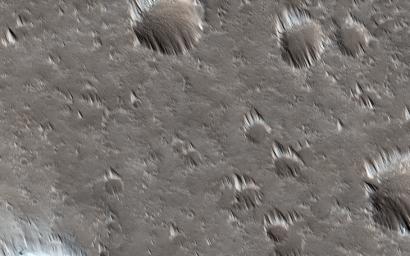
|
Looking for Changes in Dust Drifts West of Alba Mons
- Click the image above for a larger view
- Full-Res JPEG (2880 x 1800) (852.5 kB)
- Full-Res TIFF (2880 x 1800) (15.6 MB)
Caption:
This image was intended to search for surface changes after three Mars years in a dust-covered region west of the Alba Mons volcano. It was acquired at almost the exact same season as ( PSP_006271_2210 ) in 2007, and the illumination and viewing angles are very similar.
PSP_006271_2210 showed thick dust deposits accumulated downwind of topographic obstacles, apparently formed by winds blowing across the surface. These deposits, nicknamed "whiskers," are evidently rare on Mars, so far found in only a few places such as the summit of Tharsis and on the flanks of the giant volcanoes. Their ages and origins are still poorly known. We expected that wind-related changes could be taking place here in particular because of the location's low elevation in comparison to similar dust deposits elsewhere on Mars. The atmosphere is denser at this elevation, near Martian "sea-level," than at the tops of the giant volcanoes, so the winds are more effective at eroding and transporting sediment.
A comparison of the new image with the image taken in 2007 shows no discernible differences in the dust deposits. Analysis of the full image is still ongoing, but it is already clear that no major surface changes took place in this location over the three Mars year interval between the two pictures. This is instructive because it tells us that the dust deposits are resistant to wind erosion (under normal winds at least; the last major global dust storm was in early 2007, before PSP_006271_2210 was taken) and that no new dust deposition has taken place.
This result suggests that either these deposits form and evolve very slowly, over time scales much longer than three years, or else they formed during a past period when the winds were much stronger than they are today.
Background Info:
HiRISE is one of six instruments on NASA's Mars Reconnaissance Orbiter. The University of Arizona, Tucson, operates the orbiter's HiRISE camera, which was built by Ball Aerospace & Technologies Corp., Boulder, Colo. NASA's Jet Propulsion Laboratory, a division of the California Institute of Technology in Pasadena, manages the Mars Reconnaissance Orbiter Project for the NASA Science Mission Directorate, Washington.
Cataloging Keywords:
| Name | Value | Additional Values |
|---|---|---|
| Target | Mars | |
| System | ||
| Target Type | Planet | |
| Mission | Mars Reconnaissance Orbiter (MRO) | |
| Instrument Host | Mars Reconnaissance Orbiter | |
| Host Type | Orbiter | |
| Instrument | High Resolution Imaging Science Experiment (HiRISE) | |
| Detector | ||
| Extra Keywords | Atmosphere, Color, Dust, Mountain, Storm, Volcano | |
| Acquisition Date | ||
| Release Date | 2013-08-21 | |
| Date in Caption | ||
| Image Credit | NASA/JPL-Caltech/Univ. of Arizona | |
| Source | photojournal.jpl.nasa.gov/catalog/PIA17642 | |
| Identifier | PIA17642 | |
